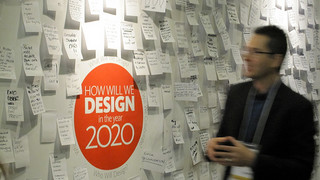Podcast: Play in new window | Download
Subscribe: Apple Podcasts | RSS
 In this episode, we discuss “design thinking,” a problem-solving approach that is now applied in business and education, as well as in the creation of new products and services. We talk with Jim Tappel, a professor at the University of Cincinnati and former IDEO employee, about how engineers might best coexist with, or even embrace, this approach to discovering new solutions.
In this episode, we discuss “design thinking,” a problem-solving approach that is now applied in business and education, as well as in the creation of new products and services. We talk with Jim Tappel, a professor at the University of Cincinnati and former IDEO employee, about how engineers might best coexist with, or even embrace, this approach to discovering new solutions.
- Jeff once used the intro and outro music of a Dire Straits song, Industrial Disease, in the background of a video featuring a robotic gripper he had designed.
- Jim is currently involved with Cooperative Education at the University of Cincinnati. At a previous point in his career, Jim worked for the well-known design firm, IDEO.
- An article that tells designers to excite engineers with performance issues is The Key to Sustainable Product Creation: The Marriage of Engineering and Design.
- Tracy Kidder’s book, The Soul of a New Machine is referenced by Jim as documenting one corporation’s willingness to fail.
- A series of increasingly capable robots from the movie, “The Incredibles,” is noted by Chris; he is probably thinking of the Omnidroids?
- Swiss watch manufacturers thought outside the box in creating Swatch watches.
- “Design Thinking” covers a broad swath of ideas, as evidenced by its entry in Wikipedia.
- Eddie Obeng has written about “foggy” projects in his book New Rules for the New World: Cautionary Tales for the New World Manager. Such efforts lack a clear objective, and the existence of any workable solution is uncertain.
- Jeff mentions a book by the CEO of IDEO, Tim Brown: Change by Design.
- We learn about the importance of “kiss off” and “suck back” in making toothpaste enticing to consumers.
- Jim estimates that when coming up with new ideas, the success rate is about 2%; it takes the courage to generate a lot of mediocre and bad concepts to find a winning solution.
- In reference to a Dan Saffer video about design thinking, Jim notes that there is more to the methodology than putting a whole bunch of post-it notes up on the wall.
Have you subscribed yet? It’s the easiest way to hear when there’s a new episode. We plan for every 2 weeks. But who can remember that? Just subscribe! Email or RSS reader or Podcatcher.
Thanks to Dawn D for the photograph from Design 2020.
I liked the “improvisational jazz” analogy to the iterative/consultative activites that go on during design. Each watching other players for ques and trying something out and checking for approval. nice.
I really enjoyed listening to the audio book of Tom Kelley and Jonathan Littman’s Ten Faces of Innovation. I was particularly influenced by their ideas on “paper thin protoypes” and their notions of anthropology and design. I think its useful to bring props to hardware design meetings. Sometimes I’ll use a bit of cardboard and blutac (moldable putty?) some components to it to foster ideas of what form some PCB might take. IDEO sounds like an interesting place to work.
I was an in-house, phone and field service technician for a time before I did any engineering work. I do think that has given me a different perspective. For some products there can be several stages of “users”. Taking something like hotel door locks (‘cos i like using them as an example). I suppose the hotel guest is the ultimate end user but the design might also need to take into consideration the staff/management of the hotel, the onsite installer and commissioner of the units. You might also consider production and Q/A staff and service techinicians “users”. You’d give some thought as to how your design will affect their tasks.
I also liked Simon Sinek’s ideas from “Start with Why” although I’m not convinced by all of his arguments. And I also like Dan Ariely’s books. I’m kind of picking and choosing notions and concepts from these and other sources and forming a composite philosophy of what humans want and why they would buy a thing.
Finally, on constant dialog during a project, this cartoon which was posted on one of our engineers walls sums it up well for me: http://www.projectcartoon.com/cartoon/2851
JD